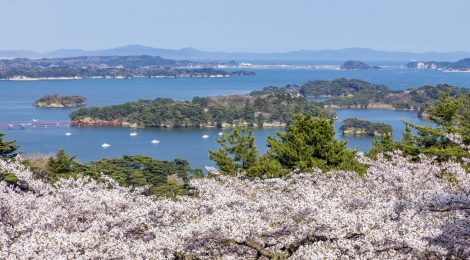
Matsushima
A bay of pine-covered islands and scenery worthy of a Basho haiku
Matsushima Bay, located in Miyagi Prefecture in Tohoku, is a picturesque destination known for its 260 islands covered in lush pine trees. It is considered one of the “Three Most Scenic Spots of japan” and has been a source of inspiration for many artists and poets throughout history. The renowned haiku poet Matsuo Basho himself struggled to capture the beauty of Matsushima Bay in his words.
Visitors to Matsushima Bay have the opportunity to explore the islands and immerse themselves in the stunning natural scenery. Some of the islands can be reached on foot, allowing for a closer look at the black and red pine forests that cover them. One of the must-visit islands is Zuiganji Temple, a historic temple that served as the family temple of the powerful Date clan, who ruled the region. The temple is a testament to the rich history and cultural heritage of Matsushima.
To fully experience the beauty of Matsushima Bay, taking a sightseeing cruise is highly recommended. These cruises offer panoramic views of the bay and its islands, providing a different perspective of the scenery. The cruises run year-round and provide bilingual audio announcements and maps to enhance the experience.
One of the highlights of Matsushima Bay is the presence of three footbridges that connect the mainland to three of the islands. These footbridges make it easy for visitors to explore the islands and enjoy the unique views they offer. The central island, adjacent to the ferry terminal, is home to Godaido Temple, a small temple that has become a symbol of Matsushima. Another island that can be accessed by footbridge is Fukuura Island, which offers a splendid view of the bay from its opposite side. Oshima Island is another accessible island where visitors can find temples and hand-carved meditation caves used by ancient monks.
Two temples of note in Matsushima Bay are Zuiganji Temple and Entsuin Temple. Zuiganji Temple is the most important Zen temple in the Tohoku region and has a rich history dating back to the 9th century. It was rebuilt by Date Masamune, the lord of the Sendai domain, in the early 17th century and is known for its exquisite architecture. Entsuin Temple, located next to Zuiganji Temple, was built by Date Tadamune in the 17th century to mourn the death of his son. The temple features both Japanese-style and Western-style gardens, with the autumn leaves being a particularly beautiful sight.
In addition to its natural and cultural attractions, Matsushima Bay is also known for its superb seafood. The bay is home to a variety of fresh seafood, including oysters, anago (saltwater eels), and grilled squid. Visitors can indulge in these local delicacies at the many restaurants and food stalls in Matsushima, including the Matsushima Fish Market.
For those seeking a traditional Japanese tea experience, a visit to Kanrantei is a must. This teahouse was originally a gift from Toyotomi Hideyoshi, the ruler of Japan, to Date Masamune, the feudal lord of Sendai. It offers a stunning view of the bay from its engawa (veranda) and serves bitter matcha green tea paired with locally-produced Japanese sweets.
Getting to Matsushima is convenient, with train and bus options available from major cities in Tokyo and the Kansai area. From Tokyo, visitors can take a 90-minute bullet train ride to Sendai on the JR Tohoku Shinkansen. From Sendai, a 40-minute train ride on the Senseki Line takes you to Matsushima. It is important to note that the Matsushimakaigan Station should be the destination, as it is closer to the tourist attractions compared to Matsushima Station.
In conclusion, Matsushima Bay is a breathtaking destination that offers a unique blend of natural beauty, cultural heritage, and culinary delights. Whether it’s exploring the pine-covered islands, visiting historic temples, enjoying a sightseeing cruise, or indulging in fresh seafood, Matsushima Bay has something for everyone. It is a place where visitors can truly experience the tranquility and serenity that inspired poets and artists throughout history. A visit to Matsushima Bay is a journey into the heart of Japan’s natural and cultural treasures.
Address And Maps Location:
Miyagi-gun, Miyagi-ken
Subscribe, follow @idbcpr and idbackpacker.com